Contemporary Wearable Art Through a Feminist Lens at Accent Sisters

“Woman was turned into plant, panther, diamond, or mother-of-pearl by mingling flowers, furs, precious stones, shells, and feathers on her body,” Simone de Beauvoir famously wrote in The Second Sex. Inspired by de Beauvoir’s musings on this subjugation of women through their attire and accessories, the exhibition But to Bestow Meaning Upon Flowers plunges into a realm where traditional wearables are no longer passive tokens of societal expectations but transformative mediums of self-expression. Masterfully curated by Zhiheng Ashely Zhang, the exhibition invited viewers to a transformative journey of self-expression and identity through wearable art, unraveling the complexities between aesthetics, identity, societal constructs, and individual expression. The exhibition was on view in October at Accent Sisters’ New Jersey outpost.
Five remarkable Asian fine artists and designers—Teng Teng, Tiantian Li, Xinyi Tao, Yin Zhang, and Asato Kitamura—and the fragrance brand Ver come together to celebrate individuality. Through their innovative lenses, a garment, an accessory or a scent is no longer just an item of adornment; it evolves into a story, a sculpture, a testament to personal agency. Their creations, intricately woven with personal narratives and deep-rooted cultural influences, break away from the shackles of convention, revitalizing familiar forms—be it jewelry, clothing, or other adornments—into powerful narratives of autonomy, self-discovery, and even defiance. Echoing the distinctive qualities of Accent Sisters, an art and literature sanctuary, Zhang has integrated feminist literature into the thematic backbone of the exhibition.
In The Second Sex, Beauvoir discusses the transformational power of adornments—how they can metamorphose women into symbolic representations. However, as Zhang points out, “It’s not about the physical transformation but the symbolic one. It’s about the identities we adopt, willingly or under societal pressure, and how we navigate these imposed roles through what we wear.” Her second source of inspiration is drawn from Virginia Woolf’s poignant scene in Mrs. Dalloway, where the protagonist reclaims her autonomy through the simple act of “buying the flowers herself.” This act serves as a pivotal clue interwoven throughout the exhibition, emphasizing the power of agency.

During the opening Zhang expanded on her curatorial concept, “Wearable art is more than just a celebration of aesthetics. It is a conversation between the creator and the wearer and between the wearer and the world. This exhibition is an exploration of that dialogue.” Drawing inspiration from the writings of Beauvoir and Woolf, Zhang paints a landscape where wearable art becomes a medium for metamorphosis, identity, and societal introspection in five chapters.
Zhang concluded, “This exhibition is an invitation to the viewer to not only appreciate the beauty of the wearable art but to question and reflect on the deeper stories and societal implications they represent. It is about understanding the power of adornments beyond their aesthetic appeal and recognizing their role in shaping identities and perceptions.”
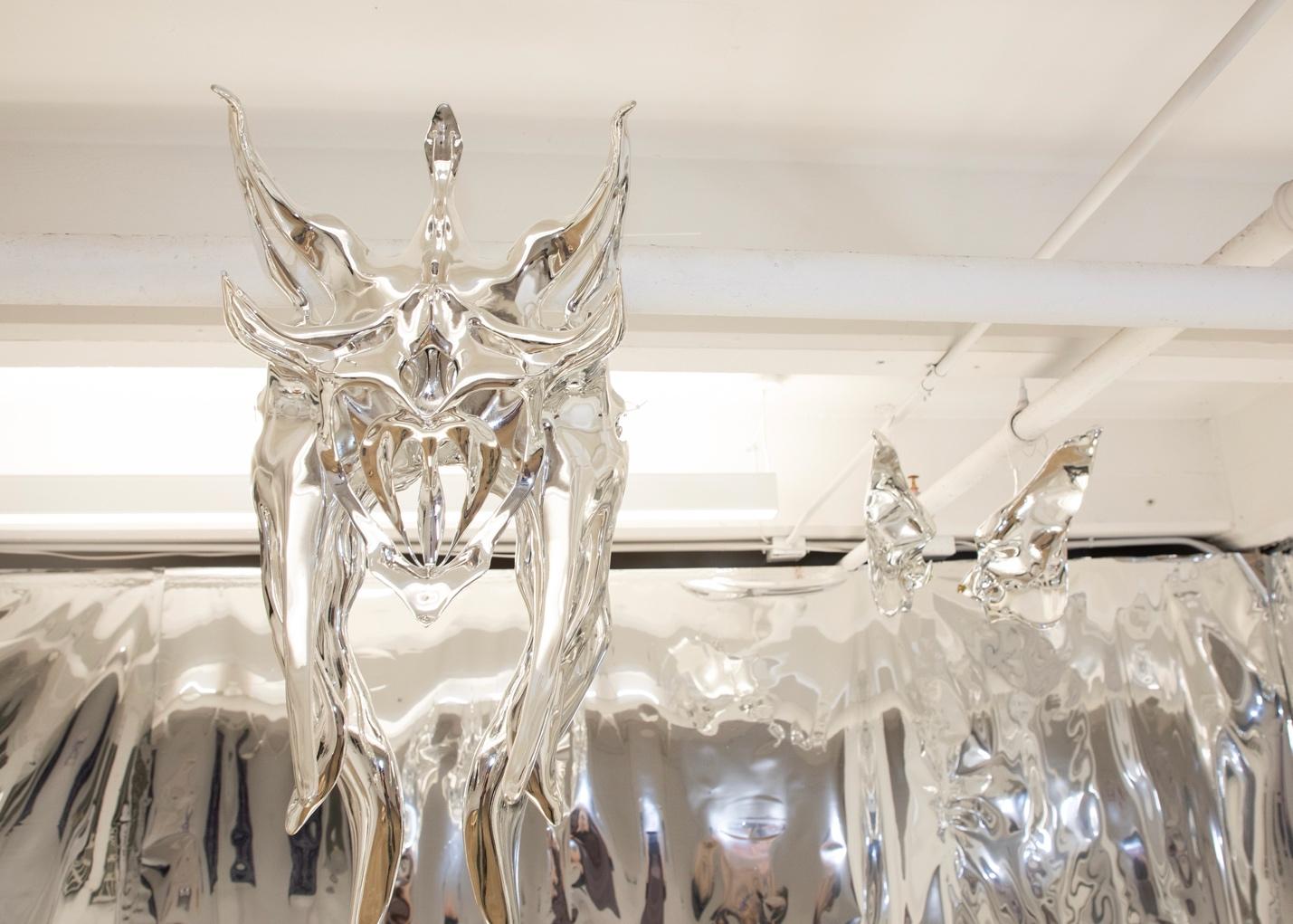
Clothing as Sculpture: XinTi Tao
Illuminated against a shimmering silver backdrop, the “Syn-biomorph” collection by Artist XinYi Tao takes center stage, commanding attention as the lights playfully dance off its contours. The term “Syn-biomorph” suggests a structure or form that combines multiple living organisms or biological elements, and also refers to living organisms birthed through synthetic means.
Deeply immersed in a sci-fi aesthetic, Tao re-envisions Biomorphism, drawing heavily from Donna Haraway’s seminal texts, “A Cyborg Manifesto” and “Simians, Cyborgs & Women – The Reinvention of Nature.” Haraway’s exploration of the “Cyborg” concept resonated with Xinyi, not only for its connotations of blurred boundaries—between the human and animal, organic and inorganic, the inherent and the fabricated—but also for its profound feminist implications.
Through Tao’s avant-garde works, a dynamic fusion of fashion and art emerges. Her silver creation, “Plankton” from “Syn-biomorph” collection, gracefully suspended from the ceiling via pipelines, conjures visions of a sleek armor that seamlessly melds with the body. Its cool hues, sharply defined shape, and overall design exude a magnificent sense of sci-fi elegance.
Haraway presentsthe Cyborg as the offspring of militarism, patriarchal capitalism, and state socialism. Haraway’s radical and liberating feminist perspectives invigorated Xinyi and reshaped her understanding of fashion’s intersection with technology. Drawing from this inspiration, Tao aspires to visualize her thoughts with non-traditional materials, challenging and redefining the Cyborg fashion from a feminine perspective.
Positioned on the ground, “Scorpion” showcases a more dramatic silhouette. When combined with a model, the two pieces merge to resemble a dark cage or a rigid exoskeleton, moving with the grace and aggressiveness of a scorpion’s limbs. In this theatrical setting, Tao’s designs are not mere wearables but evolve, transmuting into sculptures.
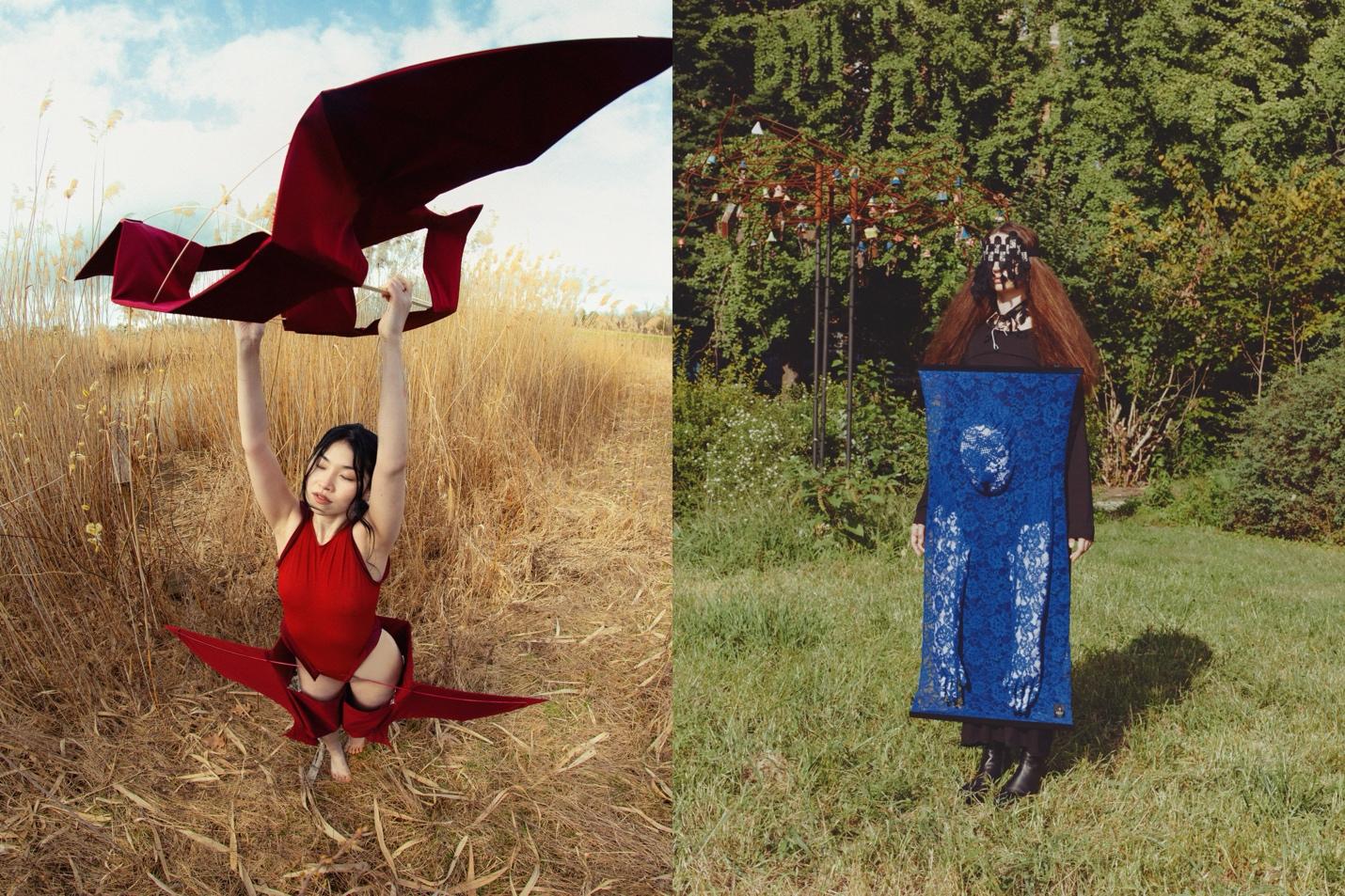
Unconventional Fashion Clothing: Yin Zhang and Asato Kitamura
Although Yin Zhang is not a native of Tibet, she possesses a profound emotional affinity for the region and its culture. Imbued with deep reverence, the whole body of the work is painted in rich and evocative Tibetan red, reminiscent of the region’s religious vestments. The “Fly a Kite” series goes beyond mere apparel, evolving into a symbol, a bridge linking humanity with nature’s vast canvas. Kite flying, as portrayed, is more than a pastime—it’s a momentary ritual, a brief yet poignant dance with the sky. As the kite ascends, we too feel an ephemeral eternity, mirroring the vastness of the heavens, a fragment of our spirit aloft amongst the clouds. While the kite’s journey towards the azure captures our imagination, its eventual descent is a grounding reminder of reality. This artistic adventure not only celebrates the rituals of kite-making and flying but also investigates the intricate relationship between fashion and humanism, weaving the fine lines that define and connect them.

As an interdisciplinary artist, Yin Zhang excels in employing fiber materials and structures to visualize her imagination, such as transforming a floating kite into a meticulously crafted garment. She delves deep into rituals, from spirituality and ritualistic behaviors to the fleeting bond between humans and nature. Each artwork stands as an intimate exploration, revealing questions she grapples with and offering viewers a glimpse into her odyssey of self-realization. Under the care and guidance of the elder women around her, and steeped in memories and reverence for her grandmother, Yin Zhang dedicates her work: “To all the people who want to send a message to loved ones or who once dared to try, even if it was with fear.”

Sharing a profound depth of emotion and humanism similar to Zhang, Asato Kitamura also brings his personal experiences into his artistic expression. Standing at the confluence of tradition and innovation, Kitamura, as a Japanese artist and fashion designer, draws significant influence from the Nichiren sect and Buddhist art of his childhood. Born into a family deeply rooted in the religious practices of Nichiren-Shoshu, his early life was surrounded by religious sculptures, Japanese myths, and Buddhist teachings. However, the fragility of his parents’ relationship that marred his household and fostered constant discord is also an undercurrent of the work. This spiritual background, juxtaposed with the tumult of a discordant household, created an environment where his creative imagination thrived, finding solace in the joys of doll play and drawing.
Fashion for Kitamura evolved into more than just an art form—it became a medium to intertwine the human experience with material form, capturing the essence of life’s trials and tribulations in wearable art. His vision for fashion, as evident in works like “Theory of Emotion” and “Symbol of Emotion (2D&3D)”, is not merely aesthetic but deeply therapeutic. Kitamura envisions it as a sanctum where past traumas are transformed and elevated into symbols of strength and beauty. Through his designs, he seeks to create a ritualistic space where individuals find self-affirmation and a path to healing, mending the emotional fabric torn by life’s adversities.
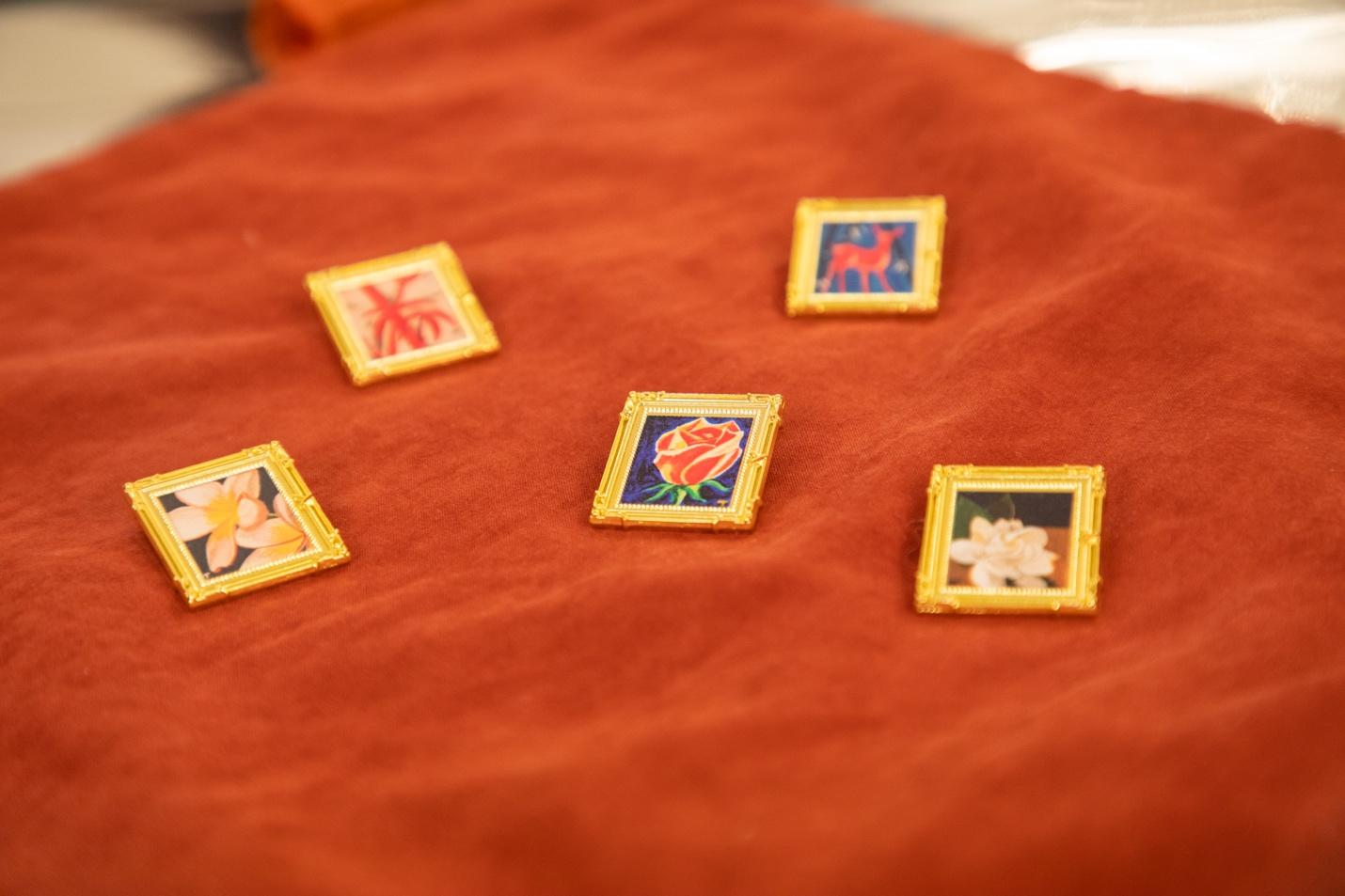
Miniature Paintings as Jewelry: Teng Teng
Teng Teng stands out as an interdisciplinary artist who masterfully intertwines the realms of art and jewelry design. Grounded in the “Art to Wear” concepts, she established her jewelry brand, Tin Tin Tint. Through this platform, her signature miniature paintings come to life, illuminating an array of subjects—from the elegance of the female representations and the delicate beauty of flora to timeless masterpieces from art history. Her works are featured in the gift section of the Metropolitan Museum of Art in New York and have made multiple appearances at New York Fashion Week and New York Jewelry Week.
Infusing her work with a vibrant female consciousness, Teng Teng meticulously portrays ancient Chinese court ladies, breathing life into their historically resonant features. The Chinese women in her paintings, drenched in gentle allure, offer a glimpse into a time when facial features represented one’s status and elegance. A particular mastery of Teng Teng’s lies in the intricate detailing of eyebrows and eyes, the windows to these women’s souls. A standout piece from the collection features a Chinese lady, her face characterized by a distinct, upright nose delicately tinted, ruby-red lips, and slender, ink-black eyebrows, quintessential traits of classical Chinese beauty.
But Teng Teng’s artistry doesn’t stop with these portraits. She further enriches her canvas by weaving in iconic Eastern motifs, capturing the deeper cultural tapestry. Plants and creatures, rich in symbolism and auspicious meanings, frequent her work. The resilience and flexibility of bamboo, the poetic serenity of reeds swaying in the breeze, and the jubilant magpies, often considered bearers of good news in Chinese folklore, all find a home in her paintings. Through these details, Teng Teng masterfully bridges the present viewer with the profound depth of ancient Chinese aesthetics and philosophy. It’s not only about aesthetic appeal but also an active engagement with the artist’s vision, a melding of the wearer’s persona with the narratives and histories embedded within the art.
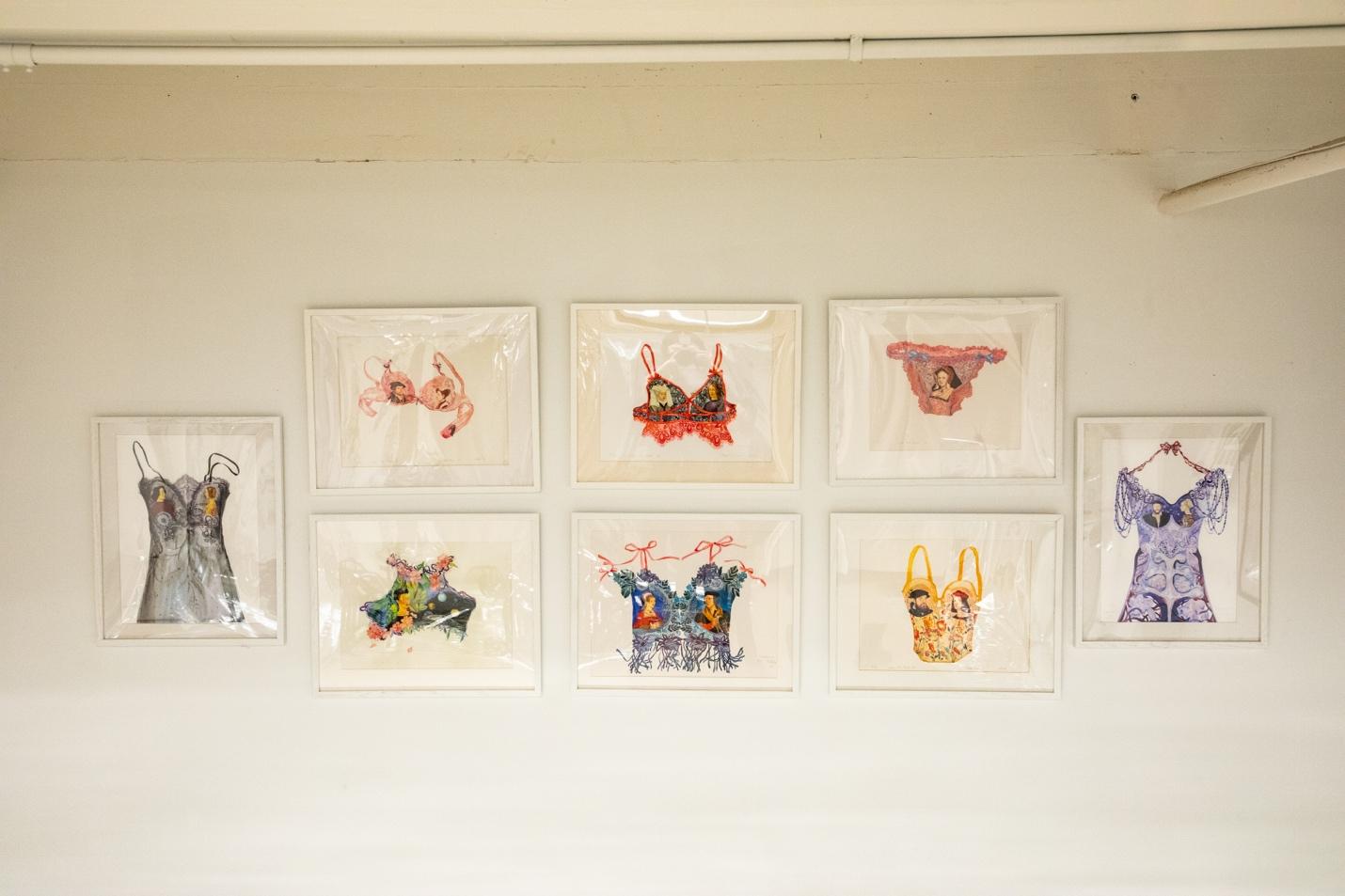

Lingerie as Art: Tiantian Li
The canvas of Tiantian Li’s works was often draped in her wardrobe, where she conjured the intricate delicacies of lace, embroidery, and the very essence of femininity through watercolor renderings, lucid and pristine.
Li is a Chinese painter and designer, now based in New York and Philadelphia. From her formative years, she was entranced by the poetic allure of traditional Chinese ink paintings, which later paved the way for her deep-rooted romance with watercolors.
Her “Love Me More” series is where her unique perspective truly blossoms. It’s a masterful blend of intimate attire depictions and classical portraiture, drawing inspiration from luminaries such as the legendary German artist Hans Holbein, the eminent court painter of King Henry VIII. The collection is a visual symphony of contrasts. The almost translucent portrayal of lingerie juxtaposed against the profound depth of portraits—crafted with finesse using Renaissance egg tempera techniques—creates a visual language that belongs to Li’s signature artistic statement.
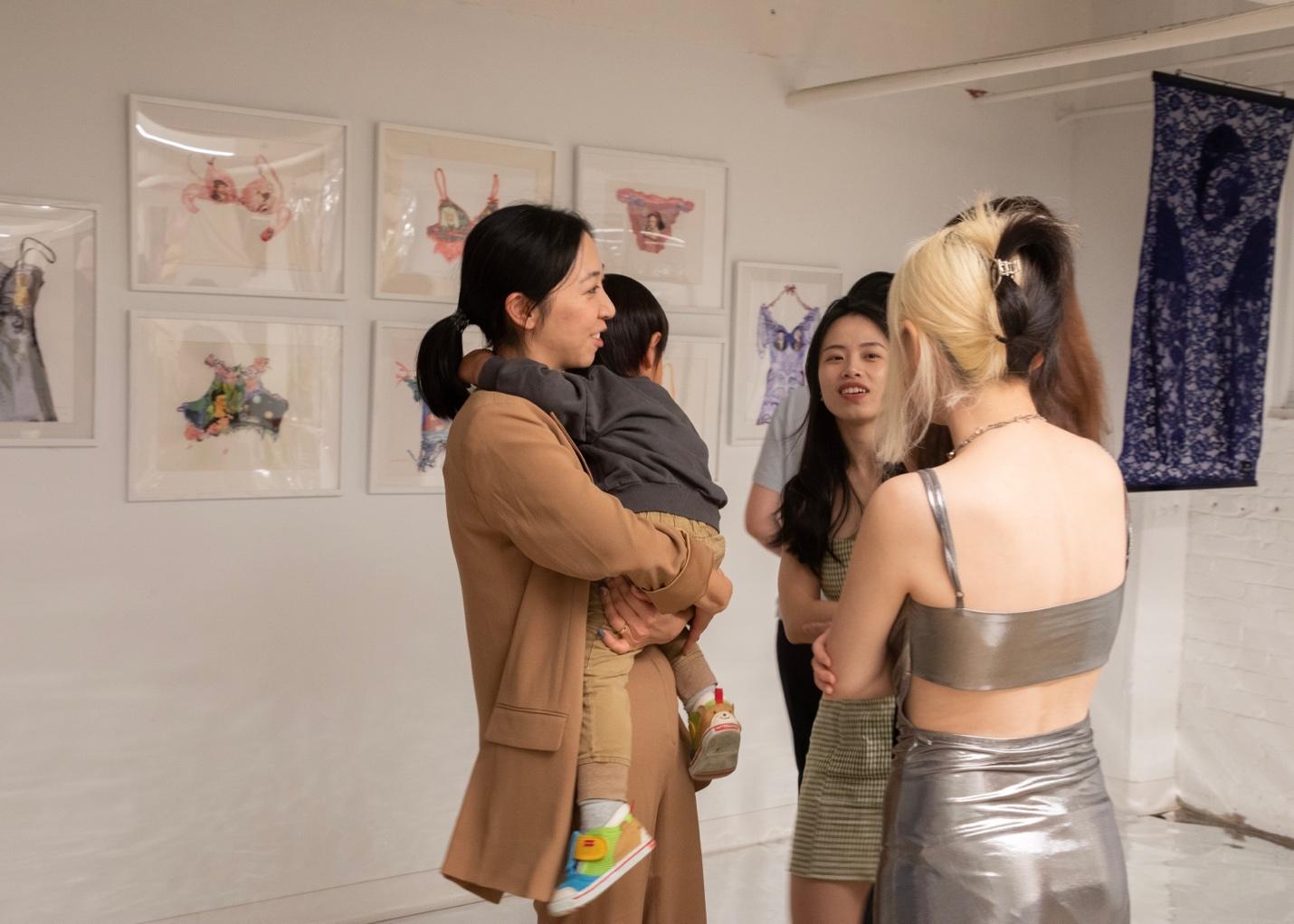
Further enriching her series, Li often turns her gaze towards iconic female artists, with Frida Kahlo serving as a recurring muse. Kahlo’s tumultuous life – marked by both personal tragedies and fierce independence – resonates with Li’s overarching theme: the universality of women’s quest for love, care, and recognition. Through her evocative “Love Me More” series, Li extends a heartfelt call to her audience, especially women, emphasizing the paramount importance of recognizing and cherishing one’s self-love and self-care. They underscore the significance of clothing and accessories, not just functional or ornamental but as powerful tools for self-expression and feminine dialogue here.
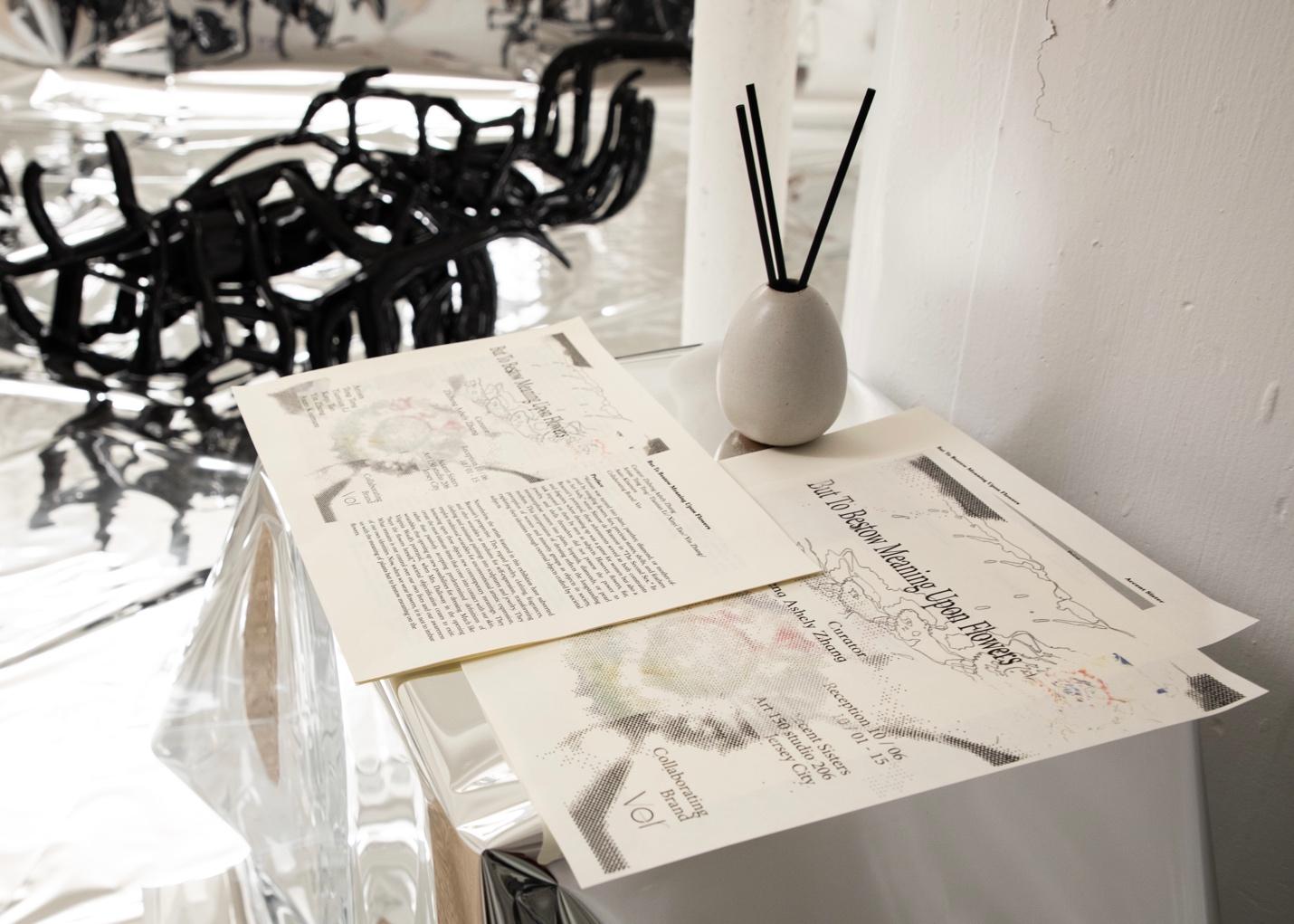
Scent as Wearable Art: Ver
Li’s delicate watercolor renderings, infused with feminine essence, set the stage for a sensory journey. As we transition from the tangible strokes of her brush to the ethereal notes of Ver’s fragrances, we are gently reminded that artistry can be experienced in myriad forms—from the visual feast of a painted canvas to the intangible embrace of a fragrance.
The Protein Collection opens the first page. In the serene ambiance of the exhibition space, viewers are transported to the lush rainforests of Paraguay, drawn by the allure of the “Tree of Life,” the Guaiac wood. Its striking green foliage, pristine white bark, and vibrant blue blossoms exude an exotic charm. The ambient fragrance, a blend of floral, woody, and earthy tones, emanates a calming aura, echoing the tree’s revered status among indigenous tribes and its role in their rituals of solace and blessing.
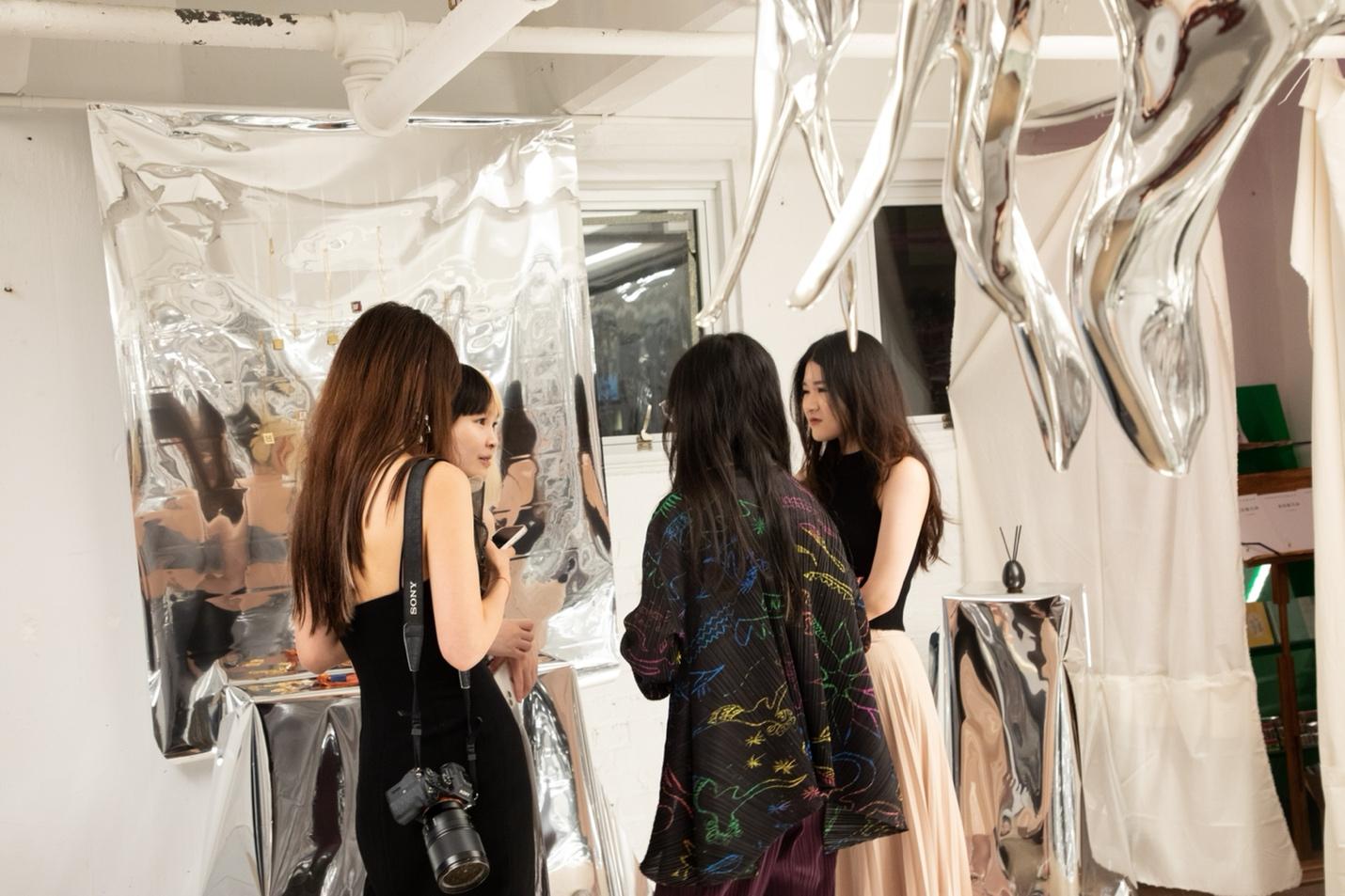
The scent, an invisible garment, intimately wraps and shapes viewers’ aura. Ver’s fragrances gently touch the face, then flow seamlessly, draping the body in a tactile scent-scape. With a soft narrative, Ver unfolds a tale of self-care, emphasizing its intrinsic importance in our journey of self-discovery and well-being.
***
Spanning five layers, But to Bestow Meaning Upon Flowers offers a journey into self-awareness and expression. Here, societal constraints are challenged, and the long-standing norms dictating identity are subverted. This is not about conforming to pre-existing labels but embracing our unique agency, control, and self-awareness. Just as Mrs. Dalloway’s purchase of flowers signifies a silent rebellion and affirmation of her agency, the act of wearing these artistic pieces is a testament to our individual stories and beliefs. We no longer wear flowers to passively mirror their essence; instead, we adorn them to infuse and narrate our tales, identities, and interpretations.
Accent Sisters is a speakeasy Chinese bookstore, publishing studio, and art space with its main location on 150 Bay Street in Jersey City and a Manhattan outpost, the Temple, on 9 Monroe Street in Chinatown. See their programming.
You Might Also Like
A Rebellion Against Uncertainty, Rehearsal Art Book Fair
“Parasites and Vessels” Conveys the Resilience of Immigrants
What's Your Reaction?
Based in NYC, Chunchun Tao is a curator, arts editor, and creative director with academic foundations from Ohio State University’s Art History and NYU's Visual Arts Administration program. Having worked in auction houses, galleries, and art advisory firms, she is deeply committed to promoting the transformative power of Contemporary art, especially among the younger Asian generation.

